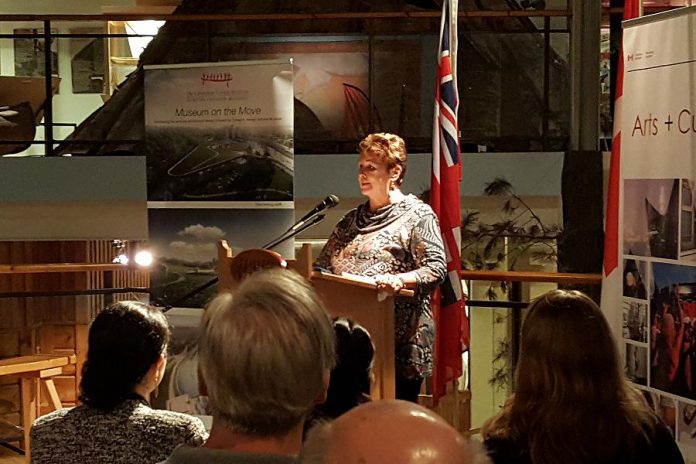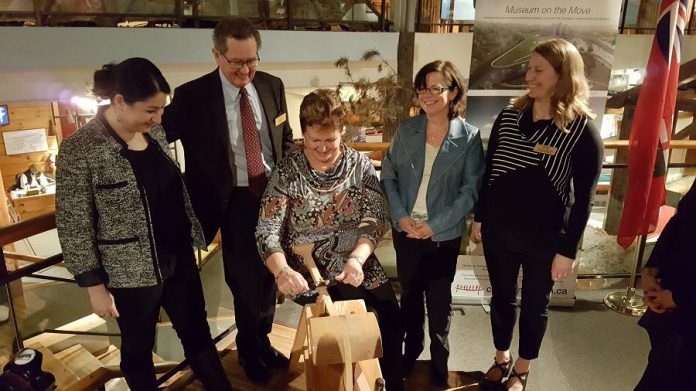
Those who think the planned new home of the Canadian Canoe Museum is still in the pipe dream stage received the definitive wake-up call Friday (February 24).
Before a large gathering of museum board members, staff and volunteers, Parks Canada employees and community leaders, Peterborough-Kawartha MP Maryam Monsef announced the project is receiving $1,410,672 from Ottawa.
Culled from the federal government’s Canada Cultural Spaces Fund, the money will cover the cost of architectural and engineering plans for the construction of the museum’s new home at the base of the Peterborough Lift Lock on the west shore of the Trent-Severn Waterway.
“The investment is a recognition of the heritage that is preserved in this space and the exceptional collection of canoes, kayaks and paddled watercraft. The canoe’s ability to tell Canada’s story is recognized with this investment,” said MP Monsef, who also serves as Minister of Status of Women.
“Cultural spaces like this matter because they bring us together. They allow Canadians to have greater access to our arts and culture, whether its performing arts, the visual arts, media arts, museum collections or heritage displays. I know the new facility will inspire museum lovers and paddlers alike.”

The Canada Cultural Spaces Fund, administered by the Ministry of Canadian Heritage, was established in 2001 to aid not-for-profit arts and heritage organizations with the improvement, renovation and construction of facilities as well as the acquisition of specialized equipment and the development of studies related to infrastructure projects. As of March 2016, $410 million had been forwarded to 1,381 projects across Canada. This year, 157 projects in 96 communities will benefit from the fund.
In his remarks, museum board chair Bill Morris termed the funding announcement “a turning point” in the ongoing journey leading to the new museum, singling out MP Monsef for being “a very strong advocate” of the museum’s redevelopment project since day one.
“This funding comes at a critical time as it allows us to continue with our pre-construction phase,” said Morris, noting the federal funding is a matching amount, prompting his thanking private donors for their contributions to date.
“The museum’s collection is a cultural asset that reflects our national heritage. We’re building a new home that aspires to be innovative; as innovative as the canoe itself. The new museum will care for the collection in the way it deserves to be cared for, and preserve it, protect it, and showcase it for generations to come.”
Morris shared that the complete collection will be accessible to visitors to the museum’s new home, noting what’s on display at any given time at the current 910 Monaghan Road location represents just 20 percent of its 600-plus paddled watercraft.
“We will be basically doubling the museum space and showing the full collection. It will be a reunion of sorts.”

Estimated to cost close to $50 million when all is said and done, the new museum, located on Parks Canada property, will be comprised of three main components: a 17,000 square foot exhibition gallery, a restaurant/café and gift shop, and a 250-seat multi-purpose room. In addition, a 20,000 square foot storage space will be accessible to an estimated 50,000 to 60,000 visitors annually — double the museum’s current attendance.
Chosen via a committee headed by former longtime Globe & Mail architectural critic Lisa Rochon, heneghan peng of Dublin, Ireland is the lead design and landscape architect, working in tandem with architect of record Kearns Mancini and landscape designer Phil Collins of Foggy River Farm. Among heneghan peng’s benchmark design projects is The Palestinian Museum in Berzeit, Palestine and the Grand Egyptian Museum situated between the pyramids and Cairo.
Opened July 1, 1997, the Canadian Canoe Museum’s birth can be traced back earlier to when a committed group of paddlers and historians welcomed the Canadian Canoe Museum collection to Peterborough from Camp Kandalore in the early 1990s.
The initial plan was to locate the museum on Little Lake beside Beavermead Park on property owned by the City of Peterborough. However, before that property could be developed, Outboard Marine Corporation (OMC), which was closing its Peterborough operation, offered to sell its office and factory space on Monaghan Road for $1. The existing buildings and infrastructure made OMC the best site option at the time.

The decision to explore relocating the museum to an on-water location in Peterborough was made at a board strategic planning retreat in 2007. Subsequent strategic planning sessions led to the articulation and expansion of two-long term objectives for the organization: build a strong and sustainable organization, and work toward re-situating, re-developing and re-inventing the museum as a national canoeing hub and a marquee tourist draw on a new site on the water in or near downtown Peterborough. That call to action was written into a strategic plan titled “Onto The National Stage, first published in 2010.
Following the formal portion of MP Monsef’s announcement, Morris said the public fundraising campaign is “a year or two down the road,” adding it’s hoped ground will be broken on site in 2019.
“A year ago we were at the bottom of the mountain looking up,” said Morris. “We’ve made significant progress and we’re gaining momentum. We’ve got a lot of work to do but we’re feeling very confident.”
“There are a number of (government) ministries that have synergies with what we’re doing here. Certainly heritage is one, but obviously First Peoples is a very important part of the museum. One of the other things is the environmental aspect of the project. There are also the economic spin-offs, so we’re hoping the industry side of things will lead to some possibilities (in terms of funding).”
To learn more about the new museum project, visit www.canoemuseum.ca/museumonthemove.


























